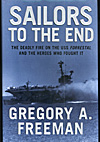 Morrow, 2002, $25.95, ISBN 0-06-621267-7, 307 pgs., hardback
Morrow, 2002, $25.95, ISBN 0-06-621267-7, 307 pgs., hardback
In war, the unexpected often happens. On July 29, 1967, a fire started on the newest US aircraft carrier: the USS Forrestal. By the time it was extinguished, 134 sailors had died and 161 were injured. It was the worst accident in US Navy history since WWII.*
Freeman's account traces the accident in minute detail, and he does an outstanding job of piecing together the whole horrible event. The research and interviews coalesce into a race between the fire reaching additional combustibles like jet fuel, missiles, and other explosives and the men scrambling to contain and squelch the flames.
At his very best, which is in the middle portions of the book, where this race can go either way, Freeman crafts a gripping narrative. Sometimes, though, there're a number of places where dialogues are inserted, which interrupts the flow. No doubt these are transcripts from interviews, but it often appears like he's trying to write a techno-thriller. It's just a little distracting at times, that's all, for it interrupts the flow of the prose and dilutes the impact of his obvious skill.
One nit to pick, and this might be an editor's decision, is in a description of Capt. Beling's WWII bombing mission in the Pacific. (Page 31-32). The text says Japanese fighter planes came up to meet his bomber, whereupon he squeezed off a shot at a twin-engine "Betty" fighter. A Mitsubishi Betty is a Japanese bomber and wouldn't intercept any US raid.
He was shot down and bailed out of his burning bomber. US Fighters circled and one dropped an inflatable life raft. I hadn't heard of this trick, but I am not 100% positive that it wasn't done. Perhaps Freeman or his editor should do some research on WWII fighters. Or maybe I should. But I'm pretty sure your typical Corsair or Hellcat didn't have a life raft to drop. A PBY, sure, but a US fighter?
Still, this is a book about the Forrestal fire and a generally well-done book it is. The tragic incident receives its due, the guilty switch is identified, and John McCain (whose plane was hit on deck by the defective missile) in one lucky future Senator.
* According to a footnote, the worst accident involving loss of life occurred in 1952 when the aircraft carrier USS Wasp ran over the destroyer Hobson, killing 176 men on the destroyer with 61 survivors (not all injured). The loss of life on the Forrestal was 134 with an additional 161 seriously injured. Thus, the total casualties were higher, though fatalities were lower. It's a statistics thing for book marketing. You can just bet they didn't want to say it was the second-worst accident in US Navy history. Who knows, maybe the author complained. Or maybe the editor. Or maybe the US Navy. In any case, whichever number you believe in, it was a bad accident, and a story well worth telling.
Back to List of Book Reviews: Modern
Back to Master Book Review List
Back to Master Magazine List
© Copyright 2002 by Coalition Web, Inc.
This article appears in MagWeb (Magazine Web) on the Internet World Wide Web.
Other articles from military history and related magazines are available at http://www.magweb.com